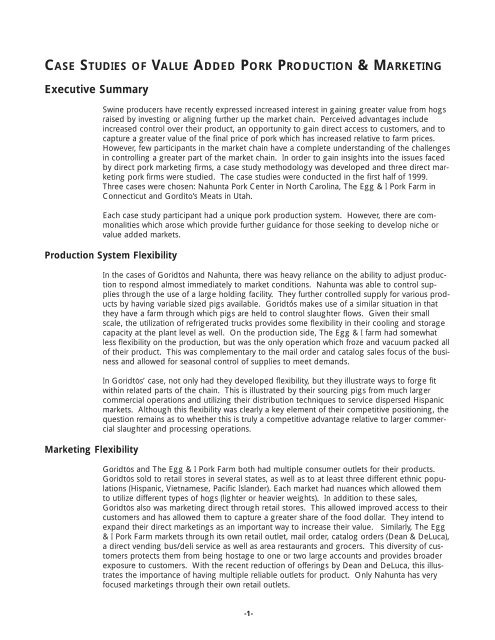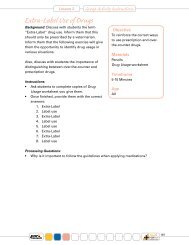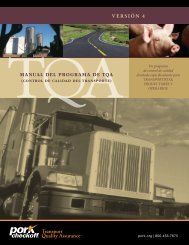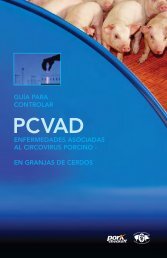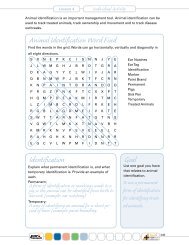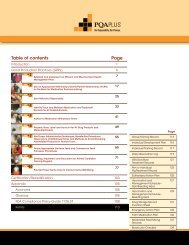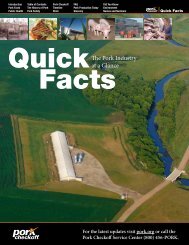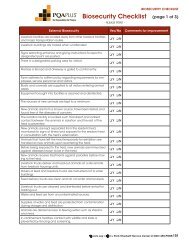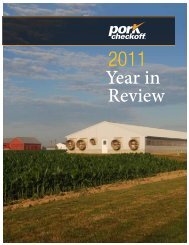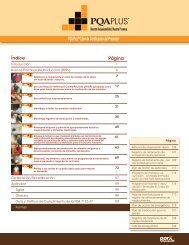Case Studies of Value Added Production and Marketing
Case Studies of Value Added Production and Marketing
Case Studies of Value Added Production and Marketing
Create successful ePaper yourself
Turn your PDF publications into a flip-book with our unique Google optimized e-Paper software.
CASE STUDIES OF VALUE ADDED PORK PRODUCTION & MARKETING<br />
Executive Summary<br />
Swine producers have recently expressed increased interest in gaining greater value from hogs<br />
raised by investing or aligning further up the market chain. Perceived advantages include<br />
increased control over their product, an opportunity to gain direct access to customers, <strong>and</strong> to<br />
capture a greater value <strong>of</strong> the final price <strong>of</strong> pork which has increased relative to farm prices.<br />
However, few participants in the market chain have a complete underst<strong>and</strong>ing <strong>of</strong> the challenges<br />
in controlling a greater part <strong>of</strong> the market chain. In order to gain insights into the issues faced<br />
by direct pork marketing firms, a case study methodology was developed <strong>and</strong> three direct marketing<br />
pork firms were studied. The case studies were conducted in the first half <strong>of</strong> 1999.<br />
Three cases were chosen: Nahunta Pork Center in North Carolina, The Egg & I Pork Farm in<br />
Connecticut <strong>and</strong> Gordito’s Meats in Utah.<br />
Each case study participant had a unique pork production system. However, there are commonalities<br />
which arose which provide further guidance for those seeking to develop niche or<br />
value added markets.<br />
<strong>Production</strong> System Flexibility<br />
<strong>Marketing</strong> Flexibility<br />
In the cases <strong>of</strong> Goridto ’ s <strong>and</strong> Nahunta, there was heavy reliance on the ability to adjust production<br />
to respond almost immediately to market conditions. Nahunta was able to control supplies<br />
through the use <strong>of</strong> a large holding facility. They further controlled supply for various products<br />
by having variable sized pigs available. Goridto’s makes use <strong>of</strong> a similar situation in that<br />
they have a farm through which pigs are held to control slaughter flows. Given their small<br />
scale, the utilization <strong>of</strong> refrigerated trucks provides some flexibility in their cooling <strong>and</strong> storage<br />
capacity at the plant level as well. On the production side, The Egg & I farm had somewhat<br />
less flexibility on the production, but was the only operation which froze <strong>and</strong> vacuum packed all<br />
<strong>of</strong> their product. This was complementary to the mail order <strong>and</strong> catalog sales focus <strong>of</strong> the business<br />
<strong>and</strong> allowed for seasonal control <strong>of</strong> supplies to meet dem<strong>and</strong>s.<br />
In Goridto ’ s’ case, not only had they developed flexibility, but they illustrate ways to forge fit<br />
within related parts <strong>of</strong> the chain. This is illustrated by their sourcing pigs from much larger<br />
commercial operations <strong>and</strong> utilizing their distribution techniques to service dispersed Hispanic<br />
markets. Although this flexibility was clearly a key element <strong>of</strong> their competitive positioning, the<br />
question remains as to whether this is truly a competitive advantage relative to larger commercial<br />
slaughter <strong>and</strong> processing operations.<br />
Goridto ’ s <strong>and</strong> The Egg & I Pork Farm both had multiple consumer outlets for their products.<br />
Goridto ’ s sold to retail stores in several states, as well as to at least three different ethnic populations<br />
(Hispanic, Vietnamese, Pacific Isl<strong>and</strong>er). Each market had nuances which allowed them<br />
to utilize different types <strong>of</strong> hogs (lighter or heavier weights). In addition to these sales,<br />
Goridto ’ s also was marketing direct through retail stores. This allowed improved access to their<br />
customers <strong>and</strong> has allowed them to capture a greater share <strong>of</strong> the food dollar. They intend to<br />
exp<strong>and</strong> their direct marketings as an important way to increase their value. Similarly, The Egg<br />
& I Pork Farm markets through its own retail outlet, mail order, catalog orders (Dean & DeLuca),<br />
a direct vending bus/deli service as well as area restaurants <strong>and</strong> grocers. This diversity <strong>of</strong> customers<br />
protects them from being hostage to one or two large accounts <strong>and</strong> provides broader<br />
exposure to customers. With the recent reduction <strong>of</strong> <strong>of</strong>ferings by Dean <strong>and</strong> DeLuca, this illustrates<br />
the importance <strong>of</strong> having multiple reliable outlets for product. Only Nahunta has very<br />
focused marketings through their own retail outlets.<br />
-1-


